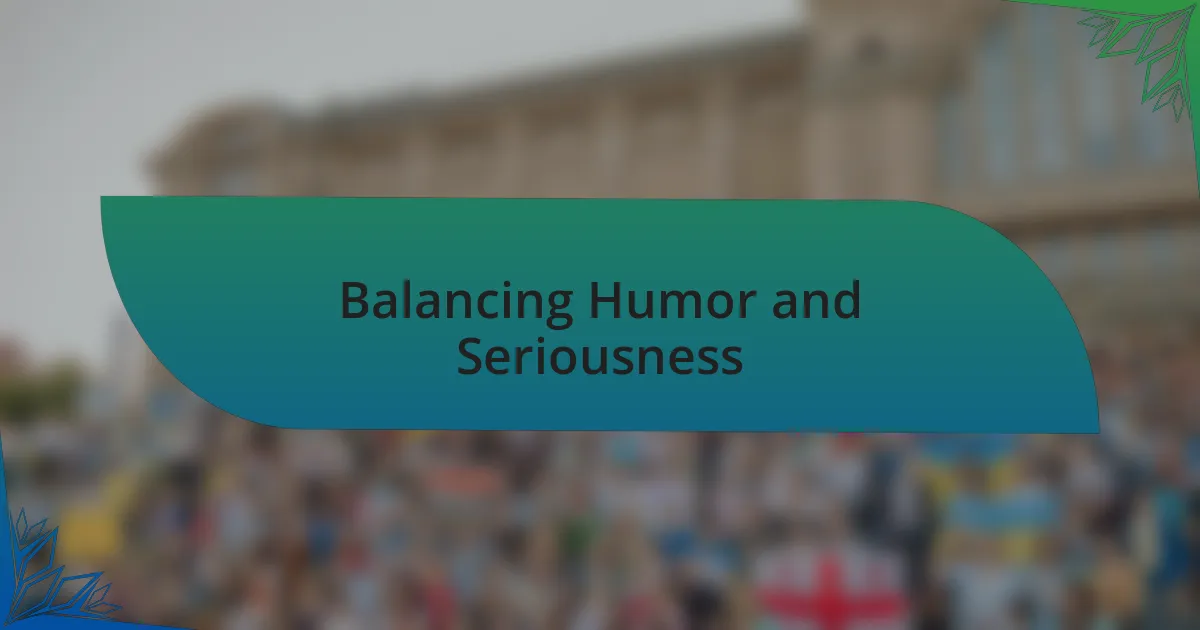Key takeaways:
- Political commentary uses satire to simplify complex issues and engage audiences, prompting critical thinking and discussions about governance and societal values.
- Effective satire employs techniques such as exaggeration, irony, and relatable characters to reveal uncomfortable truths while entertaining.
- Balancing humor with seriousness is crucial; humor can disarm audiences and foster deeper dialogue about serious topics without trivializing them.
- In writing political satire, starting with a strong premise and using clever imagery can make complex issues more relatable and spark meaningful conversations.

Understanding Political Commentary
Political commentary serves as a lens through which we can examine the complexities of governance and societal issues. I remember the first time I engaged with a political commentary piece that completely shifted my perspective—it was a satirical article that highlighted the absurdities of policy decisions. It struck me how humor could unveil serious truths, making me wonder why we often overlook the power of satire in dissecting politics.
Understanding political commentary means recognizing its multifaceted nature. Sometimes, it’s as straightforward as analyzing a speech or piece of legislation, but other times, it delves into satire, allowing us to reflect on our societal values. Have you ever found yourself chuckling at a satirical piece and then realizing it highlighted a critical issue? That moment of clarity is exactly what effective commentary can achieve.
At its core, political commentary invites us to engage with the world around us, encouraging critical thinking and introspection. I often find myself discussing these topics with friends, testing out different viewpoints. It’s fascinating to see how satire not only entertains but also prompts discussions that lead to deeper understanding and even activism.

Benefits of Using Satire
Satire effectively simplifies complex issues by distilling them into relatable narratives. I vividly recall watching a satirical news segment about election mishaps that turned a convoluted topic into something I could easily digest. It’s remarkable how humor can transform a wonky policy discussion into a humorous yet poignant reflection on civic responsibility.
One significant benefit is that satire cultivates critical thinking by encouraging audiences to question norms. I once shared a satirical piece that made fun of a local government blunder at a dinner gathering. The laughter that ensued quickly morphed into a serious debate about accountability and governance. How often do we engage in such discussions without the initial spark of humor?
Moreover, satire serves as a powerful tool for social change by shedding light on injustices in a way that resonates with people emotionally. I remember being moved by a satire that tackled economic inequalities; it not only made me laugh but also inspired me to donate to a local charity. Isn’t it fascinating how humor can ignite empathy and motivate individuals to act? This intersection of comedy and activism is where the true strength of satire lies.

Techniques for Effective Satire
To craft effective satire, one method I find particularly compelling is exaggeration, or what we might call “hyperbole.” This technique amplifies faults or absurdities to a ludicrous extent, often revealing uncomfortable truths in the process. I remember reading a satirical piece about politicians treating public service like a reality show, with all the drama and antics that go with it. The over-the-top scenario made me chuckle while simultaneously prompting me to reflect on the seriousness of our political climate.
Another important technique is the use of irony, where what is said contrasts sharply with what is meant. For instance, when a comedian joked about a utopian society governed by social media influencers, I couldn’t help but laugh, but it also struck me as a critique of our obsession with superficiality. Isn’t it interesting how the absurdity of such a suggestion can lead us to evaluate our values?
Finally, incorporating relatable characters can make satire more engaging. I once watched a skit featuring a bumbling politician whose mishaps mirrored real-life scandals and gaffes. By using familiar personalities, the satire not only entertained but also drew me into a critical examination of leadership qualities. I mean, don’t we all know someone who reminds us of that character? Engaging with satire this way makes the conversation richer and more personal.

Balancing Humor and Seriousness
When I think about balancing humor and seriousness in satire, I often reflect on how a well-crafted joke can be a gateway to deeper discussions. I remember attending a stand-up show where the comic tackled healthcare issues. He started by joking about the absurdity of the billboards advertising miracle cures while people were struggling to pay for basic treatments. The laughter that erupted was a release, but it also pushed the audience to confront that uncomfortable reality.
Navigating this balance isn’t always straightforward, and I sometimes find myself questioning where to draw the line. For example, during a campaign rally, I overheard a satirist comparing political debates to celebrity feuds. As funny as it was, I realized it carried a weight—highlighting how distracted we’ve become by persona over policy. Isn’t it fascinating how humor, when used skillfully, can highlight glaring issues without coming off as preachy?
In my experience, it’s crucial to avoid trivializing serious matters. There was a time when I hesitated to joke about climate change, fearing it might undermine the urgency of the crisis. However, I found that clever satire can make people more receptive to the gravity of such topics. Engaging audiences through humor can disarm them, create space for dialogue, and ultimately foster awareness. Don’t you think that laughter can sometimes open doors that earnestness struggles to touch?

Personal Experiences with Satire
I have always been drawn to the clever use of satire, especially when it relates to social justice issues. I recall a time when I joined a workshop on political caricature. It was eye-opening. We were encouraged to illustrate serious topics like inequality with humor. One participant drew a cartoon of a politician sitting on a pile of money while citizens looked up in dismay. The laughter it sparked felt cathartic, yet it left us all contemplating the stark reality behind the humor.
In a different instance, I penned a satirical article about the pitfalls of social media activism. I used the metaphor of “hashtag heroism,” poking fun at how easily people can click their way to feeling virtuous without real action. As I wrote, I felt this mix of excitement and apprehension; would readers get the irony? The response was overwhelmingly positive, highlighting the need for a deeper conversation about genuine involvement versus performative actions. It’s moments like these that make me wonder—can humor truly bridge the gap between apathy and awareness?
Finding the right angle in satire often feels like walking a tightrope. Once, I made a light-hearted comment about the absurdity of political debates being staged like reality shows. It garnered laughter but also sparked debates among friends about the seriousness of those events. What I realized was how conversations stemming from satire can uncover layers of thought that are often overlooked. Doesn’t it demonstrate the power of humor in challenging our perceptions?

Tips for Writing Political Satire
One effective tip for writing political satire is to start with a strong premise that resonates with your audience. I once crafted a piece about politicians’ promises, framing it as a ‘best-of’ list of outrageous pledges that never materialized. The humor wasn’t just in the exaggeration; it lay in the collective recognition of disappointment. How often have we found ourselves laughing at the absurdity of unfulfilled expectations in politics?
Another crucial aspect is to employ clever wordplay and imagery that help distill complex issues. I recall writing a satirical piece where I compared a budget proposal to a buffet—everyone gets excited, but few realize it’s just a feast for the select few. Readers appreciated the comparison, as it made the intricate topic of fiscal policy digestible, yet thought-provoking. Isn’t it fascinating how a metaphor can make even the driest subjects more engaging?
Incorporating current events lends authenticity and relevance to your satire. During a particularly heated election season, I penned a humorous take on the mob-like behavior of media coverage. It was a bit outrageous, but it sparked spirited discussions about the media’s role in shaping public perception. I’ve learned that effectively capturing the zeitgeist not only entertains but also encourages readers to reflect on contemporary issues more critically. How can satire not serve as both a mirror and a magnifying glass for our times?